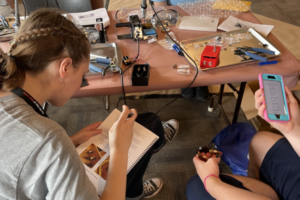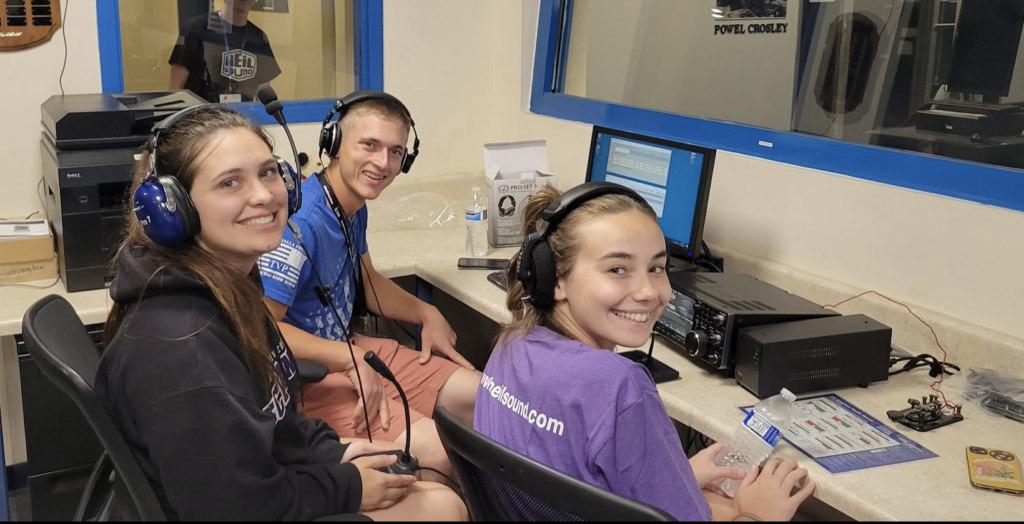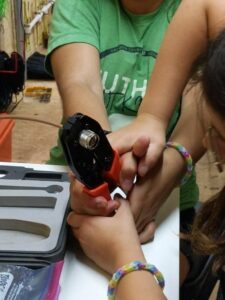ARDC grantees are developing the next generation of amateur radio leaders
A question that you often hear at amateur radio events is, “Where are all the kids?” Indeed, it sometimes seems that young people are nowhere to be found. Though you may not see many kids at traditional amateur radio events, such as hamfests and club meetings, they are out there. Below, you’ll see how two organizations – with ARDC’s help – are working to get kids involved in the hobby and helping them become tomorrow’s leaders.
YOTA Camp builds skills, fosters friendships
Youth on the Air (YOTA) is a program for and by young amateur radio operators in the Americas. Modeled after the Youngsters on the Air program in IARU Region 1 (Europe, Africa & Middle East), the goal of the program is to build skills, foster lasting friendships, and connect mentors with younger hams.
YOTA Camp is one of the program’s key events. Aided by a $35,500 ARDC grant, the 2022 camp was held June 12 – 17, 2022 at the National Voice of America Museum of Broadcasting in West Chester Township, Ohio, just north of Cincinnati. 9 girls and 12 boys attended the camp and participated in a number of activities, including an in-depth tour of the museum, fox hunting, a high-altitude balloon launch, HF operation, satellite operation, and kit building.
I spoke with several of this year’s attendees, including Abby, KK7CFJ; Katie, KE8LQR; and Kyle, KE0ZNV; and they all said that they had a great time. Lyle described his experience as “astronomically awesome.” Katie said it was “too short.” Abby said, “All of the experiences were great, but meeting others was the best part.”

At YOTA Camp 2022, attendees built attenuator kits, which they later used in the fox hunt. Photo: Sterling Mann, N0SSC.
Abby’s favorite activities were fox hunting and kit building. The fox hunt was more than just finding the hidden transmitter, though. To help them find the fox, the campers built an offset attenuator. By building the attenuator and then participating in the fox hunt, Abby said she was able to better understand how the whole process worked, and she got a real kick out of using equipment that she built herself.
Katie’s favorite activity was the high-altitude balloon launch. The balloon’s payload included an APRS beacon, a video camera, a voice beacon, and even an insect, for a study of how high altitude affects insects. The campers also launched a smaller balloon with a WSPR beacon.
Lyle enjoyed operating HF at the camp. He noted that at least three of the campers made their first HF contact at the camp. He also said that he’s made it his mission to get more youth on HF and maybe into contesting.

Some YOTA Camp 2022 attendees made their first HF contacts at this year’s camp. Pictured here are Adam Johnson, KD9KIS; Veronica Romanek, KD2UHN; and Marissa Collier, KE8SSG.
Katie enjoyed the balloon launch so much that she’s working on a balloon launch for her high school amateur radio club in Columbiana, OH. She’s currently the club president, and in addition to the balloon launch, she’s working on getting more women into amateur radio.
Abby is also trying to get more kids into ham radio so that she can share all the fun she’s having with the hobby. In addition to her recruiting efforts, Abby wants to learn CW.
As you can see, not only is the YOTA camp teaching campers technical skills, but leadership skills as well. The 2023 YOTA Camp will take place on July 16-21, 2023, at Carleton University in Ottawa, Ontario, Canada. A team from the Radio Amateurs of Canada (RAC) will serve as the local host for this event. To be eligible to attend the camp, you have to be a licensed radio amateur between the ages 15 and 25. For more information, check out the 2023 Camp web page.
4H is about more than raising livestock
When you think of the 4H club, you undoubtedly think of raising goats and pigs, but the Fauquier County (VA) 4H Club is about more than that. Their programs—including their amateur radio club—engage youth in a variety of experiential learning opportunities and community service activities. By serving in leadership roles, the club’s members learn both leadership skills and life skills.
The Fauquier 4-H Ham Radio Club provides members, ages 9 to 18, opportunities to explore science, technology, engineering, art, and math through amateur radio communications and electronics projects. An amateur radio license is not required to join, but the club encourages members to get their license if they wish to do so.
A $34,000 ARDC grant allowed the club to purchase and equip a ham radio trailer for the club. The solar-powered trailer allows the club’s young members to explore science and technology and to showcase amateur radio. It has two operating positions. The HF Station consists of an ICOM IC-7610 connected to either a whip antenna or one of the club’s homebrew wire antennas. The VHF/UHF Station is running an Icom IC-9700 with a Diamond X-6000A tri-band vertical. For portable or D-STAR operation, the club has an Icom IC-705 transceiver.
 Club members were heavily involved in the trailer project. They learned how to make power cables, crimp and solder coaxial connectors (see right), and how to connect the radios and computers together. The kids also created the information posters in the trailer to explain ham radio to visitors. One of the posters, which the kids named Alphabet Soup, explains the phonetic alphabet and Q-signals. Another, titled What Does the Fox Say describes fox hunting and radio direction finding.
Club members were heavily involved in the trailer project. They learned how to make power cables, crimp and solder coaxial connectors (see right), and how to connect the radios and computers together. The kids also created the information posters in the trailer to explain ham radio to visitors. One of the posters, which the kids named Alphabet Soup, explains the phonetic alphabet and Q-signals. Another, titled What Does the Fox Say describes fox hunting and radio direction finding.
The club uses the trailer to demonstrate their enthusiasm for amateur radio at regular meetings and events, such as ARRL Field Day, county fairs, and hamfests. These community outreach events focus on introducing people to amateur radio by showcasing what the kids are doing and by giving community members the chance to make on-air contacts. The trailer is the club’s primary station, so if you’ve made contact with N4HKZ, chances are you’ve talked to someone in the trailer.
In addition to the operating events, the club conducts other STEAM-related activities. For example, they recently built code practice oscillator kits and have listened to transmissions from the International Space Station. As with the operating events, the goal of these activities is to give the club members a feel for what science and engineering is all about and encourage them should they express an interest in pursuing either as a career.
They’re not raising livestock, but what they are doing in Fauquier County is raising the next generation of amateur radio leaders. ARDC is proud of the work they’re doing there and is more than happy to help.
Are you concerned about where our next generation of leaders is coming from? Do you have an idea for a program that will encourage young people to become not only radio amateurs, but leaders as well? Apply for a grant.